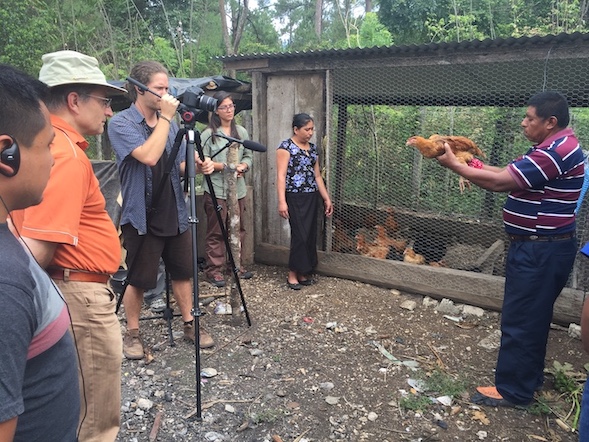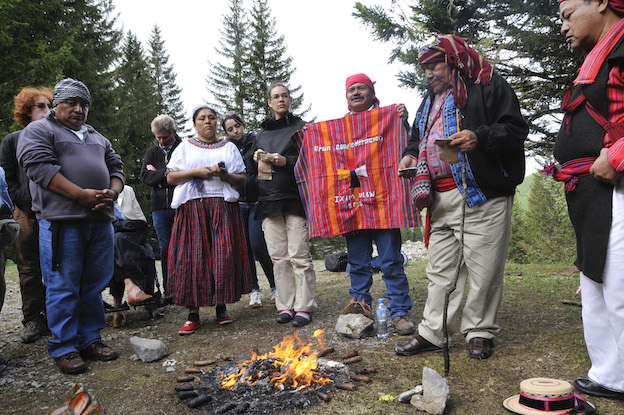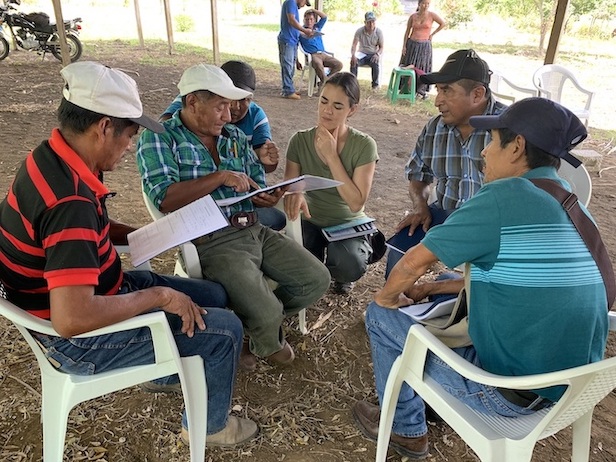That Sunday morning the words came from my colleague José, secretary of the Q’eqchi’ Council of Elders Releb’aal Saq’e’(ACGERS), located in Poptun, Petén… “Tata Mingo is dead, he was lit on fire by his own neighbors a few minutes ago… He was accused of witchcraft.” My knees succumbed, unable to let sink in the story José kept repeating over the phone, as if to make sure I was grasping the full gravity of what happened. Domingo Choc Che, a gentle soul and wise Ajilonel, expert on medicinal plants and practitioner of Maya Spirituality, and my research colleague, had been murdered. “The others are afraid,” José went on, “what if they start coming after all of us?” At that moment, the weight of my academic decisions felt like a punch in the stomach. I told myself we had been careful; we knew the area and had researched the risks extensively. Yet my ignorance of the subjacent complex local dynamics seemed unequivocal. The ACGERS Council was pushing the boundaries of a new type of research, in full trust of our partnership. That day changed me as an anthropologist and as transdisciplinarian. In this article I reflect on what it means to push and transgress the boundaries of collaborative research and how we may be asked to become a new species of social scientist.

Dr. Jakob Zinsstag (Swiss TPH) and Ajilonel Crisantos Botzoc exchanging and documenting knowledge on a case study concerning zoonotic disease surveillance. Photo by author.
Shelving Disciplinist Thought
As a young anthropologist I viewed the world through a permanent ethnographic lens, infatuated with the potential of my own discipline to make visible societal aspects buried deep under layers of racism, cultural myopia, exclusion, or mere ignorance. Equipped with reflexive goggles, I felt confident I could apply the emic-etic distinction (Headland et al., 1990) to discuss any emerging issue with my non-social science colleagues on our intrinsic bias when interpreting other people’s ideas and behaviors. This came handy when negotiating development interventions with donors that, to me, seemed to miss the mark of cultural pertinence or tackle the actual heartfelt issue from the perspective of those deemed ‘beneficiaries’. In spite of my arrogance, I was not oblivious to the complexity of the ‘real world’ and the limitations of looking at any issue from a single disciplinary view. Interdisciplinary approaches became the new norm, pushing us to develop so called ‘T skills’ (Johnston, 1978) that could negotiate bridges between academic boundaries. While conducting a research project on adaptation to climate change in Lake Atitlán in 2005, climatologists, archaeologists, biologists, forest engineers and others helped my team develop an understanding of the complexity of what local communities had been doing to build resilience to extreme climate challenges. In such interdisciplinary teams, the debate increased exponentially regarding the relationship of empirical science to societal values. Social scientists do not limit themselves to describing, for example, gender violence or poverty; but rather consider these as unacceptable and thus do not make a strictly scientific, descriptive statement, but a normative, value statement as well. Overcoming the disciplined-base fragmentation of science in favor of recognizing inherently coupled complex systems, means that ‘true or false’ and ‘right or wrong’ statements never have clear-cut boundaries. The study of our own axiology becomes then a critical point to review.
When Hurricane Stan hit the lake in 2005 and mudslides killed thousands, our town of San Juan had no casualties. A mudslide buried an entire barrio, yet all dwellers were evacuated just in time to avoid a tragedy. Later on, the Mayor explained the town Elders had urged him in the middle of the night to remove people from their homes, claiming the mountain was about to collapse. It had been raining for days, electricity and telephone lines were down and there was no information from the outside world. How did the Elders know which part of the town was going to be covered by the mudslide and when? All our technology had failed. The answer of Don Domingo, a Tz’utujil town elder, was clear: “Maybe you should consider that not all knowledge is in books, that there are other ways of knowing that don’t rely on machines but on a connection to Mother Earth, and that spirit precedes observed matter.” That day was the beginning of what became for me a deep dive into Maya science and into a different value system.
In the interdisciplinary team I described earlier, a group of traditional Maya Ajq’ij (day keepers -spiritual guides) and Ajq’omaneel (medicine specialists) was asked to join as members of the research group. They received a salary and participated in all research activities, which led to a book (Azurdia and Ivic, 2008). This process went beyond participatory approaches and the debate of what constitutes ‘good social science’. What does it mean to expand the research-driver to include other epistemologies, ontologies, cosmologies and axiologies (beyond academics) at equal footing? Here I want to clarify that by ‘academic’ I mean a person formed in a discipline in a formal-education facility such as a university, representing a dominant epistemology of the so-called Modern Western world. This differs from the word ‘scientist,’ which I use to refer to an expert researcher versed on his or her own epistemology. In this sense, all knowledge systems have their own producers of knowledge, their own scientists.

Elders of the Q’eqchi’, Kaqchikel, K’iche’, Mam and Mopan groups exchanging knowledge in the transdsiciplinary workshop of the MACOCC project in Switzerland and in Guatemala. Photo in Ürnash, where the elders held a ceremony at the base of the Alps and exchanged with traditional Swiss healers. Photo by Pius Kruetli.
Exceeding Transdisciplinarity
Husserl’s coining of the term ‘life-world’ had brought forward as early as 1939 the aspect of a joint experience of the world, a collective inter-subjective pool of perceiving where nonetheless it was possible to reach an objective truth. Mittelstrass (1992) went on to define transdisciplinarity as a form of research transcending disciplinary boundaries in order to address and solve problems related to the life-world. Hirsch Hadorn et al. (2008) defined transdsiciplinarity as a process where academics enter a dialogue that fosters mutual learning with other societal stakeholders, where science becomes a part of societal processes and contributes explicit and negotiable values and norms, as well as attributing meaning to knowledge for societal problem solving.
A decade ago, I landed in the Transdisciplinarity (TD) Lab at the Federal Institute of Technology in Zurich, to conduct my PhD research within this TD framework. I had studied and applied CBPR (Minkler et al., 2011) before, a form of Participatory Action Research (PAR), but felt ultimately that the focus was on producing societal change and not much came back to change academia itself. In PAR, after research is over, we can go back to our ways, perhaps with novel methodologies, but most likely not questioning a need for growth within our own epistemology. Transdisciplinarity, as coined by this Zurich team (Staufaccher et al., 2012), filled that gap with their claim to not only engage in societal transformations, done through equal footing between representatives of all collaborating knowledge systems, but also by promoting an active process for deep mutual-learning for co-producing socially robust knowledge. It sounded great. The experience later proved to be extremely exciting and uncomfortable.
Through that first transdisciplinary research process, I learned shoulder-to-shoulder with the Ajkamal B’ey (path leaders) of five Councils of Maya Elders, and colleagues from foreign and local universities, what cultural humility in research is about. The MACOCC (Maya and Contemporary Conceptions of Cancer) project ran for five years. It set the basis for understanding there is much room left to push the boundaries of science (CMMN, 2016; Berger et al., 2016a), and that social scientists have a key role to play in co-developing methods to facilitate mutual-understanding and promote mutual-learning in complex intercultural settings (Berger et al., 2016b; Vides, 2019).
It also showed the deep limitations of the original TD model developed in a perfect democracy of the global north, highlighting its shortcomings to produce real ‘equality’ (epistemic and otherwise) and resilience in a setting like Guatemala: a multicultural, emerging democracy full of power differentials, historical trauma, mistrust and conflict. It also showed the limits of most academics’ will to share resources and power equally with our Maya partners and local counterparts. Once more, the debate on our value systems became heated. This became the motivation to develop three other transdisciplinary projects in Guatemala, centered on public health topics, through global partnerships. This time, the focus went to developing decolonizing transdisciplinary approaches more greatly influenced by the ‘Epistemologies of the South’ ( De Sousa, 2011) and the precepts of an ‘ecology of knowing-systems’, intent on making visible the contributions of those ‘saberes otros,’ traditional knowledge systems made invisible since colonial times, towards developing our own models for reaching health sovereignty (Basille, 2018).

The author (in green) working with Ajilonel elders from ACGERS chosen to be part of the Green Health project. Tata Domingo Choc is seen wearing a black and red shirt. Photo by Daniela Ochaita.
Accounting for Unknowns
This brings me back to the ACGERS Council of Elders in Peten. Domingo Choc Che had been working for two years on two of these transdisciplinary research projects with our Unit of Medical Anthropology team in Universidad del Valle de Guatemala. He was part of our intercultural, international team where European and Guatemalan academics, along with representatives of the Ministry of Health and the Council for Protected Areas (CONAP), underwent a “research for development” project with Maya scientists of the Releb’aal Saq’e’ Council. The project included documenting ethnomedical and phytotherapy knowledge of the Q’eqchi’ and Peruvian Amawaka populations and to study their embeddedness in plurimedical systems, currently in conditions of inequity. One of the main goals was to examine needed changes to the official healthcare provision system of Guatemala and Peru, and discuss in a larger Latin American forum to be held in 2021, the creation of new healthcare models more culturally pertinent for indigenous populations and negotiate viable avenues for implementation.
In essence, the Q’eqchi’ council was to become the local referent for intercultural transdisciplinary processes. More importantly to Tata Mingo and the ACGERS members, this research was providing evidence of their intellectual property for its protection and for triggering national recognition of medicinal Maya Science. It also enabled them to negotiate engaging in an ABS (access and benefit sharing) contract with a foreign partner to produce commercial goods derived from their own traditional knowledge on plants, for local income generation. The former activity and the associated implementation of a local medicinal plant nursery do not constitute ‘research’ in itself. However, the process by which societal interactions are forged in mutually agreed terms to foster mutual-learning and to produce a sustainable ‘solution’ to locally perceived problems (poverty, deforestation, abuse of indigenous knowledge, non-pertinent healthcare), is an important object of transdisciplinary research. Tata Domingo, Jose and each Elder involved in this research pushed the boundaries of what was ‘normal’ in their communities of origin. What was already there, that ancient herbal knowledge quietly existing at the societal margins, was made more visible, more prominent, less easy to ignore. We had prepared to receive attacks from the mainstream world, from academics, from some form of the status quo, even from Maya scholars, but failed to see the underlying complexity of a colonial legacy confronting traditional Maya knowledge with the intolerance and ignorance of religious fanaticism, right there where the Elders live. Domingo Choc was called a ‘scientist’ by us, an ‘Ajilonel’ by his colleagues from the Council, and a ‘witch’ by his own neighbors. This is not the place to address the historical, structural and social layers of complexity that might explain this persecution, but indeed a place to reflect on how ‘empowering’ or ‘participatory’ research approaches don’t come without a (seemingly imponderable) societal cost. Are we really ready, as social scientists, as local-global citizens, to hold ourselves accountable for how our own axiology, no matter how worthy we might believe it to be, impacts the collaborative world we imagine and co-create around us? Is our view of a more equitably-built society created through collective intelligence, a naive approach? Or is it a needed defiance to push us to mature as interconnected societies?
Nicolescu (1996) describes Transdisciplinarity as that which is at the same time in-between disciplines, through different disciplines, and beyond all discipline. It leaves room for accepting the unknown, for recognizing that we have ill-defined boundaries, for accepting the uncomfortable emptiness between subatomic particles, that space that we can’t see, hold, or plan for. I have four children and cannot afford to be a cynic, so within this place of transgression I will continue to question myself and my research approaches reflexively. “What if they start coming after all of us?” is a question still posed by the Elders, resonating hard within. To me there is no ‘them’ and ‘us.’ No “those attacked” and “those safe”. There is only One of us, one amidst all our beauty, all our ugliness, all our colorful cultural diversity. I believe we are capable of learning to co-exist; I believe social sciences have a great role in this process. This is in fact, an invitation.
References
Azurdia, I. & Ivic, M. (2008). Ciencia y Técnica Maya. Editorial Cholsamaj: Guatemala.
Basille, G. (2018). La Salud Internacional Sur Sur: Hacia un giro decolonial y epistemológico. II Dossiers Salud Internacional Sur Sur, CLACSO (República Dominicana: FLACSO).
Berger-Gonzalez, M, Vides, A., Heinrich, M., Strauss, S., Taquira, S., Krütli, P. (2016)a. Relationships that heal: Going beyond the patient-healer dyad in Mayan therapy. Journal of Medical Anthropology: cross-cultural studies in health and illness. Vol 35 (4): 353-367 DOI 10.1080/01459740.2016.1141408
Berger-Gonzalez, M., Staufaccher, M., Zinsstag, J., Edwards, P., Krütli, P. (2016)b. Transdisciplinary research on cancer healing systems between biomedicine and the Maya of Guatemala: A tool for reciprocal reflexivity in a multi-epistemological setting. Journal Qualitative Health Research. Vol 26 (1): 77-91 DOI 10.1177/1049732315617478
CMMN- Concejo Mayo de Médicos Mayas por Nacimiento. (2016). Raxnaqi’l Nuk’aslemal, Medicina Maya en Guatemala. Editorial Cholsamaj: Guatemala.
De Sousa Santos, B. (2011). Epistemologıas del Sur. ́ Rev. Int. Filos. Iberoam. Teor. Soc 16, 17–39.
Headland, T., Pike, K., Harris, M. (eds). 1990. Emics and Etics: The Insider/Outsider Debate. Sage.
Hirsch Hadorn, G., Biber-Klemm, S., Grossenbacher- Mansuy, W., Hoffmann-Riem, H., Joye, D., et al. (2008) The emergence of transdisciplinarity as a form of research. In: Hirsch Hadorn, G., Hoffmann-Riem, H., Biber-Klemm, S., Grossenbacher, W., Joye, D., et al. (eds) Handbook of Transdisciplinary Research. Springer, Heidelberg, Germany, pp. 19–39.
Johnston, D. L. (1978). Scientists Become Managers-The “T”-Shaped Man. IEEE Engineering Management Review, 6(3), 67–68. doi:10.1109/emr.1978.4306682
Laurell, A. (2010). Revisando las políticas y discursos de salud en América Latina. Med. Soc 5, 79–88
Minkler, M., and Wallerstein, N. (eds). (2011). CBPR For Health: From Process to Outcomes. 2nd ed San Francisco, CA: Jossey Bass.
Mittelstrass, J. (1992) Auf dem weg zur transdisziplinarität. Gaia 1(5), 250.
Nicolescu, B. (1996). Manifiesto: La Trasndisciplinariedad. Ediciones Du Rocher: Caracas.
Stauffacher, M., Krütli, P., Flüeler, T., & Scholz, R. (2012). Learning from the transdisciplinary case study approach: A functional-dynamic approach to collaboration among diverse actors in applied energy settings. In D. Spreng, T. Flüeler, L. Goldblatt, & J. Minsch (Eds.), Tackling longterm global energy problems: The contribution of social science (pp. 227–246). Dordrecht, The Netherlands: Springer.

1 Trackback